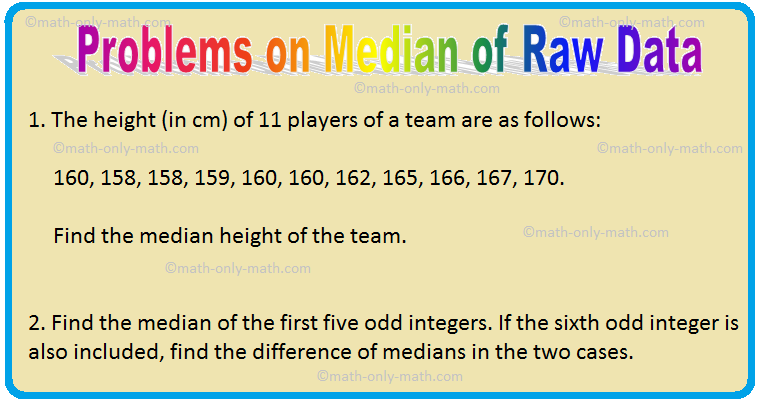Subscribe to our ▶️ YouTube channel 🔴 for the latest videos, updates, and tips.
Problems on Median of Raw Data
Median is another measure of central tendency of a distribution. We will solve different types of problems on Median of Raw Data.
Solved Examples on Median of Raw Data:
1. The height (in cm) of 11 players of a team are as follows:
160, 158, 158, 159, 160, 160, 162, 165, 166, 167, 170.
Find the median height of the team.
Solution:
Arrange the variates in the ascending order, we get
157, 158, 158, 159, 160, 160, 162, 165, 166, 167, 170.
The number of variates = 11, which is odd.
Therefore, median = \(\frac{11 + 1}{2}\)th variate
= \(\frac{12}{2}\)th variate
= 6th variate
= 160.
2. Find the median of the first five odd integers. If the sixth odd integer is also included, find the difference of medians in the two cases.
Solution:
Writing the first five odd integers in ascending order, we get
1, 3, 5, 7, 9.
The number of variates = 5, which is odd.
Therefore, median = \(\frac{5 + 1}{2}\)th variate
= \(\frac{6}{2}\)th variate
= 3th variate
= 5.
When the sixth integer is included, we have (in ascending order)
1, 3, 5, 7, 9, 11.
Now, the number of variates = 6, which is even.
Therefore, median = mean of the \(\frac{6}{2}\)th and (\(\frac{6}{2}\) + 1)th variate
= mean of the 3th and 4th variates
= mean of 5 and 7
= (\(\frac{5 + 7}{2}\)
= (\(\frac{12}{2}\)
= 6.
Therefore, the difference of medians in the two cases = 6 – 5 = 1.
3. If the median of 17, 13, 10, 15, x happens to be the integer x then find x.
Solution:
There are are five (odd) variates.
So, \(\frac{5 + 1}{2}\)th variate, i.e., 3rd variate when written in the ascending order will the medina x.
So, the variates in ascending order should be 10, 13, x, 15, 17.
Therefore, 13 < x < 15.
But x is an integer.
So, x = 14.
4. Find the median of the collection of the first seven whole numbers. If 9 is also included in the collection, find the difference of the medians in the two cases.
Solution:
The first seven whole numbers arranged in ascending order are
0, 1, 2, 3, 4, 5, 6.
Here, the total number of variates = 7, which is odd.
Therefore, \(\frac{7 + 1}{2}\)th, i.e., 4th variate is the median.
So, median = 3.
When 9 is included in the collection, the variates in the ascending order are
0, 1, 2, 3, 4, 5, 6, 9.
Here the number of variates = 8, which is even.
Therefore, median = mean of the \(\frac{8}{2}\)th variate and the (\(\frac{8}{2}\) + 1)th variate
= Mean of the 4th variate and the 5th variate
= mean of 3 and 4
= \(\frac{3 + 4}{2}\)
= \(\frac{7}{2}\)
= 3.5.
Therefore, the difference of medians = 3.5 – 3 = 0.5
5. If the numbers 25, 22, 21, x + 6, x + 4, 9, 8, 6 are in order and their median is 16, find the value of x.
Solution:
Here, the number of variates = 8 (in descending order).
8 is even.
Therefore, median = mean of the \(\frac{8}{2}\)th variate and the (\(\frac{8}{2}\) + 1)th variate
= Mean of the 4th variate and the 5th variate
= Mean of x + 6 and x + 4
= \(\frac{(x + 6) + (x + 4)}{2}\)
= \(\frac{x + 6 + x + 4}{2}\)
= \(\frac{2x + 10}{2}\)
= \(\frac{2(x + 5)}{2}\)
= x + 5.
According to the problem,
x + 5 = 16
⟹ x = 16 - 5
⟹ x = 11.
6. The marks obtained by 20 students in a class test are given below.
Marks Obtained
6
7
8
9
10
Number of Students
5
8
4
2
1
Find the median of marks obtained by the students.
Solution:
Arranging the variates in ascending order, we get
6, 6, 6, 6, 6, 7, 7, 7, 7, 7, 7, 7, 7, 8, 8, 8, 8, 9, 9, 10.
The number of variates = 20, which is even.
Therefore, median = mean of \(\frac{20}{2}\)th and (\(\frac{20}{2}\) + 1)th variate
= mean of the 10th and 11th variates
= mean of 7 and7
= (\(\frac{7 + 7}{2}\)
= (\(\frac{14}{2}\)
= 7.
From Problems on Median of Raw Data to HOME PAGE
Didn't find what you were looking for? Or want to know more information about Math Only Math. Use this Google Search to find what you need.



New! Comments
Have your say about what you just read! Leave me a comment in the box below. Ask a Question or Answer a Question.